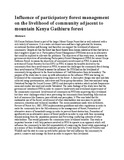| dc.description.abstract | Mt Kenya Gathiuru forest is part of the larger Mount Kenya Forest that is well endowed with a rich variety of resources. It is a water catchment area and has a high potential for tourism, recreational facilities and farming 'and therefore can support the livelihood of adjacent community. Despite all this the forest has faced threats from human related activities that have a direct negative impact on it. Participatory Forest Management (PFM)was seen as an alternative that could be explored to alleviate the problems.
The objectives of this study were; to assess the government objectives of introducing Participatory Forest Management (PFM) for mount Kenya Gathiuru Forest; to assess the objectives of community involvement in PFM; to assess the activities of Kenya Forestry Service(KFS) in PFM, to assess the benefits derived by the community from their involvement in PFM; to assess the challenges the community faced during their involvement in PFM and to assess the influence the PFM had on the livelihood of community living adjacent to the forest a distance of 5 tolOkilometres from its boundary.
The purpose of the study was to come up with information on the influence PFM was having on livelihood of the community living adjacent to the forest. A descriptive design was used and data collected using questionnaires, interviews and Focus group discussion. Data was analyzed using Statistical Package for Social Science (SPSS) and descriptive statistics which include frequencies mean and modes was used and results Tabulated.
The main findings of the study were that the government 'introduced PFM in order to conserve biodiversity and livelihood improvement of the community concerned. Involvement of community in PFM was improving their livelihood but there were challenges which were preventing the community from benefiting fully such as lack of resources like finances, poor attitude and perception. It Was concluded that for sustainable use of the forest, involvement of other stakeholders was necessary to provide resources, education and technical knowhow.
The recommendations made were as follows; Review of Forest Act, 2005, PFM implementation guidelines and other regulations in order to make the community have the full autonomy in the management of forest; Promotion of alternative source of household energy in order to prevent forest destruction; Promotion of agroforestry as an alternative source of forest products in order to cope with their increasing demand arising from the population pressure and Preventing conflicting interests of other stakeholders. This would guarantee the community more livelihood benefits.
This study is important because it will help partners involved in PFM to operate in an approach which will influence the community to take full responsibility of conserving the forest while appreciating it as a source of their livelihood and eradicate poverty. It will help the Ministry of Forestry and Wildlife and the state to come up with better policies that will influence the community to protect, conserve and manage the forest in order to improve their livelihood. | en_US |

